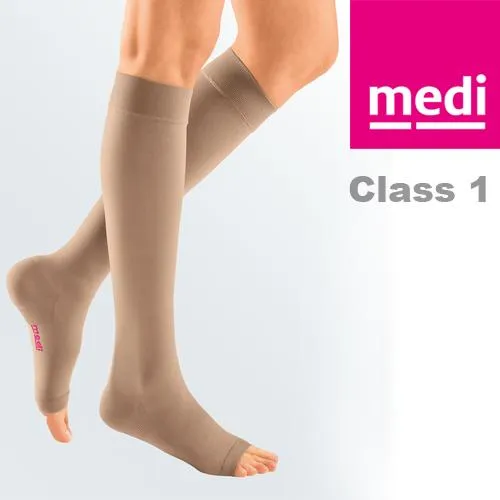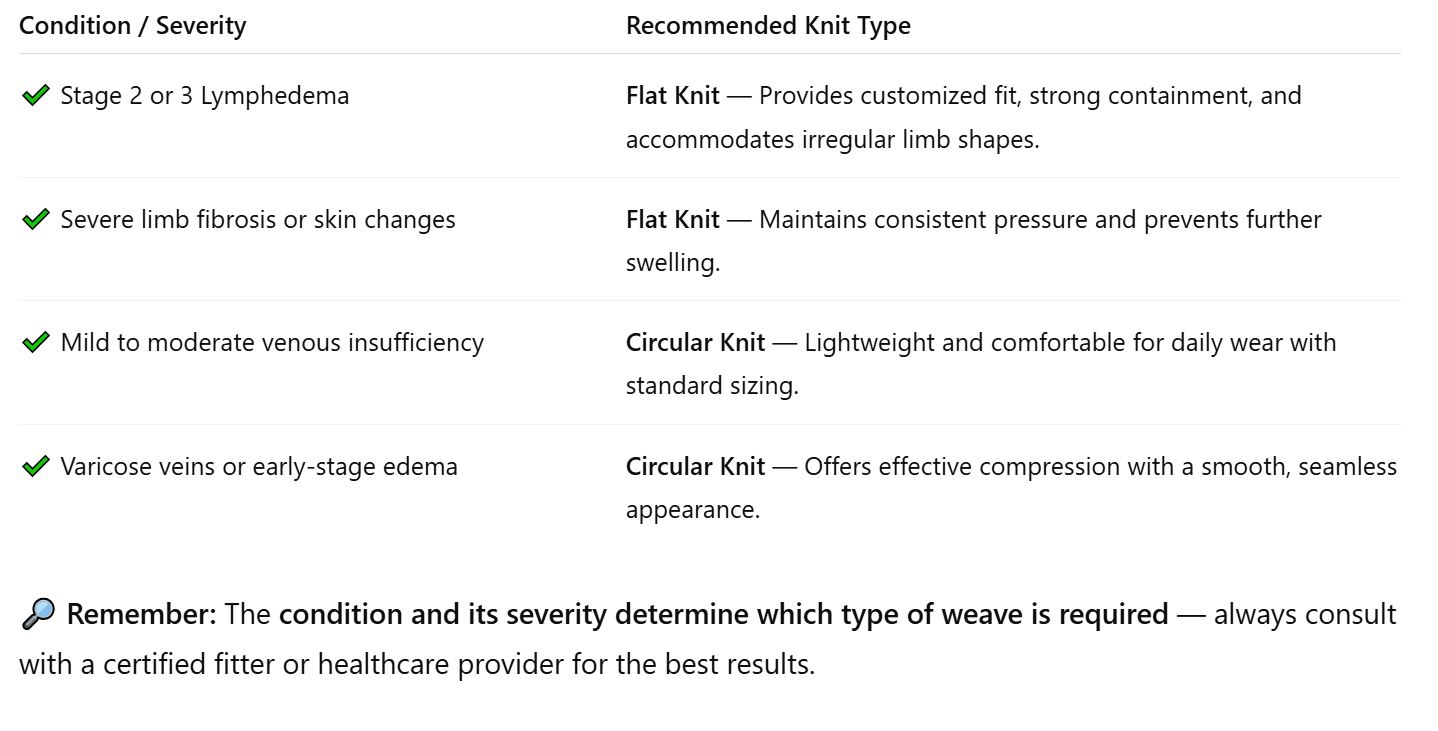
Flat Knit vs. Circular Knit Compression Garments: How to Choose
“When it comes to compression therapy, a proper fitting isn’t just important — it’s essential. Ill-fitting garments can do more harm than good. That’s why our team takes the time to educate patients and make sure every compression stocking or sleeve fits perfectly.” - Michele Kattine
Flat Knit vs. Circular Knit Compression Garments: What New Jersey Patients Need to Know
Compression therapy is a lifeline for many people in New Jersey living with lymphedema, venous disorders, or other conditions requiring specialized garments. But not all compression stockings or sleeves are created equal. At MCB DME, we often hear patients asking: What’s the difference between flat knit and circular knit compression garments? Understanding this distinction is essential for choosing the right treatment option — one that delivers the best fit, comfort, and medical outcomes.
In this comprehensive guide, we’ll break down what flat knit and circular knit compression garments are, how they’re made, who they’re best suited for, and what factors to consider when selecting the right product for your needs. If you’re looking for compression garments in Hawthorne, Paterson, Ridgewood, or anywhere in Northern New Jersey, read on to feel confident about your choice.
Understanding Compression Garment Construction
The way a compression garment is knit determines more than just its appearance — it affects stretch, durability, customizability, and how well it addresses swelling.
What Are Flat Knit Compression Garments?
Flat knit compression garments are made using a process where the yarn is knitted into a flat piece of fabric and then sewn together to form a sleeve, stocking, or glove. This technique allows for:
Variable tension control, providing gradient compression precisely where it’s needed.
Customization, because flat knit garments can be individually tailored to unique limb shapes — ideal for irregular or highly contoured limbs often seen in advanced lymphedema.
Thicker, more robust material, offering better containment of swelling.
Seams, which result from stitching the flat fabric together.
Flat knit garments are particularly suited for patients with Stage 2 or 3 lymphedema, where significant swelling, fibrosis, or limb shape changes require a garment designed to maintain consistent compression throughout the day.
What Are Circular Knit Compression Garments?
Circular knit compression garments are created on a knitting machine that produces a seamless, tubular garment. Features include:
Uniform, cylindrical shape, providing smoother, more cosmetic appearance under clothing.
Thinner, lighter fabric, which can be more comfortable for daily wear.
Limited customization, since these garments rely on standard sizing.
Circular knit stockings are commonly recommended for milder edema, chronic venous insufficiency, or varicose veins, where a standard size can provide adequate compression without needing a tailored fit.
The Key Differences: Flat Knit vs. Circular Knit
Here’s a closer look at how these garment types stack up:

For a more technical breakdown, check out Medi’s excellent article on flat knit vs. circular knit garments.
Why Flat Knit May Be Better for Lymphedema Management
In our Hawthorne, NJ showroom, many patients with lymphedema require flat knit garments because of their ability to deliver consistent, firm compression. This is crucial in controlling the progression of lymphedema by:
Preventing fluid buildup.
Softening fibrotic tissue.
Reducing risk of cellulitis.
Since these garments can be tailored to accommodate limb shape fluctuations, they maintain better skin contact and pressure, essential in preventing swelling from worsening.
Patients across Bergen and Passaic counties often remark on the durability of flat knit stockings, which typically outlast standard circular knit garments with proper laundering.
When to Consider Circular Knit Garments
For patients in areas like Wayne, Fair Lawn, or Glen Rock, NJ, who experience milder swelling due to varicose veins or venous insufficiency, circular knit compression stockings can be a cost-effective, discreet solution.
They’re lightweight, making them easier to wear all day, especially during warmer months. Many local residents appreciate the minimal bulk under pants or dresses, which allows them to maintain a professional appearance at work while still managing swelling.
Custom vs. Ready-to-Wear: The Local Advantage
One of the biggest benefits of working with a local provider like MCB DME is having experienced compression fitters on hand. Unlike buying compression garments online without guidance, an in-person fitting ensures:
✅ Accurate limb measurements
✅ Assessment of skin condition and severity of swelling
✅ Education on donning, doffing, and garment care
MCB DME’s certified fitters work closely with local vascular surgeons, lymphedema therapists, and rehabilitation specialists to recommend the most appropriate garment type and compression class for your condition.
Real-World Examples from New Jersey Patients
One of our patients from Montclair, NJ, came to us after struggling with off-the-shelf circular knit stockings that constantly rolled down her thigh. She was frustrated, as the garments caused discomfort and failed to control her swelling.
After we fitted her with a custom flat knit thigh-high stocking, she experienced significant improvement in swelling reduction and comfort. The thicker material provided better containment, and the tailored fit prevented slipping — transforming her daily routine.
Another patient in Paramus, NJ, with moderate venous insufficiency, found circular knit compression socks effective at reducing evening ankle swelling. He appreciated the lighter material for his busy retail job, which kept him on his feet all day.
Important Considerations When Choosing Compression Garments
Severity of Swelling – More advanced lymphedema or significant limb shape changes almost always require flat knit.
Cosmetic Preferences – Patients who value a smoother look may lean toward circular knit.
Activity Level – Athletes or those with active lifestyles might prefer lightweight circular knit stockings.
Insurance Coverage – In New Jersey, some insurance plans provide reimbursement for medically necessary compression garments; flat knit customs may require prior authorization.
Caring for Your Compression Garments
Whether you choose flat knit or circular knit, proper care can dramatically extend the life of your garments:
Wash daily using a gentle detergent (free of bleach or softeners).
Always air dry, avoiding direct heat sources.
Inspect garments regularly for signs of wear, loss of elasticity, or tears.
The Importance of Professional Fitting in Hawthorne and Beyond
New Jersey residents don’t need to travel far to get expert help with compression therapy. At MCB DME in Hawthorne, our fitters are here to guide you through every step, from measurement to education. We stock a wide range of compression stockings, sleeves, gloves, and accessories from trusted brands, including Medi, Jobst, Juzo, and Sigvaris.
With flat knit and circular knit options available, we make sure you find the right garment to control swelling, improve mobility, and protect your skin health.
Ready to Take Control of Your Lymphedema or Swelling?
Compression therapy can significantly improve your quality of life when properly selected and fitted. Whether you live in Hawthorne, Ridgewood, Clifton, or nearby, MCB DME is your local resource for expert compression garment fittings, education, and ongoing support.
📞 Call us today at (973) 304-9988 or visit www.mcbdme.com to schedule your personal compression garment fitting appointment.
Additional Resources
For more in-depth comparisons, we recommend:
